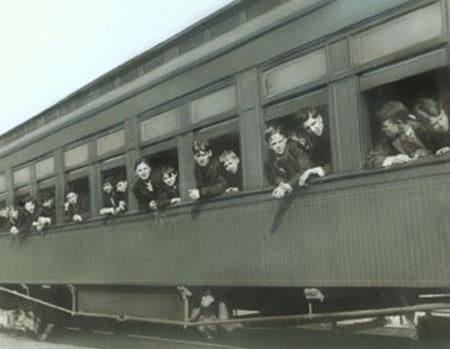It's one of most compelling stories from America's history: Between 1854 and 1929 thousands of children from Eastern cities were sent to the Midwest and West on "Orphan Trains." On March 7, 2010, Homestead National Monument of America will host an Orphan Train historian and one of the few remaining Orphan Train Riders for a special program.
Homestead National Monument of America, located in southeastern Nebraska, is an appropriate location for the talk. The park "commemorates the Homestead Act of 1862 and the far-reaching effects it had upon the landscape and people. It was one of the most significant and enduring events in the westward expansion of the United States."
Some of those homesteads also became homes for children on the Orphan Trains. According to the Nebraska State Historical Society,
"Between 1854 and 1929 more than 200,000 children rode "orphan trains" from Eastern cities to the Midwest and West to be placed in foster homes. The Children's Aid Society in New York City initiated the program in an attempt to provide wholesome homes for orphaned children who might otherwise face a life of poverty and crime. In fact, many of these children were not orphans at all, but had parents who were unable to care for them."
"Some orphan train riders found loving families and were adopted; others were regarded as cheap labor and worked long hours at home or in the fields. Changing attitudes toward keeping families together, new state and local laws funding foster care and prohibiting out-of-state placement, and child labor legislation brought about the end of the orphan trains in 1929."
On Sunday, March 7, 2010, Homestead National Monument of America will host Orphan Train historian Charlotte Endorf and one of the few remaining Orphan Train Riders, Lela Newcombe. Charlotte Endorf is the author of Plains Bound: Fragile Cargo: Revealing Orphan Train Reality and By Train They Came.
Charlotte Endorf has extensively researched the phenomenon of clearing orphanages by sending children out west. She will tell the moving stories of the lives that changed forever by the Orphan Trains.
Orphan Train Rider Lela Newcombe will tell her touching story as part of this program. Lela Newcombe discovered late in life that it was a paper mistake that landed her and her siblings on an orphan train. You’ll hear how her parents tried to find her, but were unable to do so.
"The message of the lives of the Orphan Train riders is one of endurance, perseverance and survival. We are very excited to be able to have a person who lived through this part of our history share her story and answer questions," stated monument Superintendent, Mark Engler.
The program will begin at 2 p.m. on March 7 at the park's Education Center, and will be followed by a book signing by Charlotte Endorf. Homestead National Monument of America is located about 35 miles south of Lincoln, Nebraska. You'll find driving directions on the park website.


 Support Essential Coverage of Essential Places
Support Essential Coverage of Essential Places







Comments
I had the wonderful opportunity to visit Homestead last July. Besides learning how to properly pronounce Beatrice (be-AY-triss), Nebraska, I discovered an absolutely fascinating gem of a place. The interpretive displays in the VC were a real reflection of the outstanding skills and talents of the folks at Harpers Ferry. The staff there was outstanding. Of all the very many NPS areas I've visited, Homestead stands out!
If there's one big issue in Beatrice, Nebraska it's probably the debate over Homestead Act. People have come to Beatrice, Neb., since 1862, when the Homestead Act first parceled out land to pioneer farmers. The U.S. was in a different place at that time, economically.
I read this here: Beatrice, Nebraska, giving away land to generate revenue
Now small towns like Beatrice have formed their own Homestead Act of 2010 in order to dole out land to reap the benefits of real estate tax revenue. Recurring property tax is something Beatrice needs more than more baseball fields and parks, reports the New York Times.